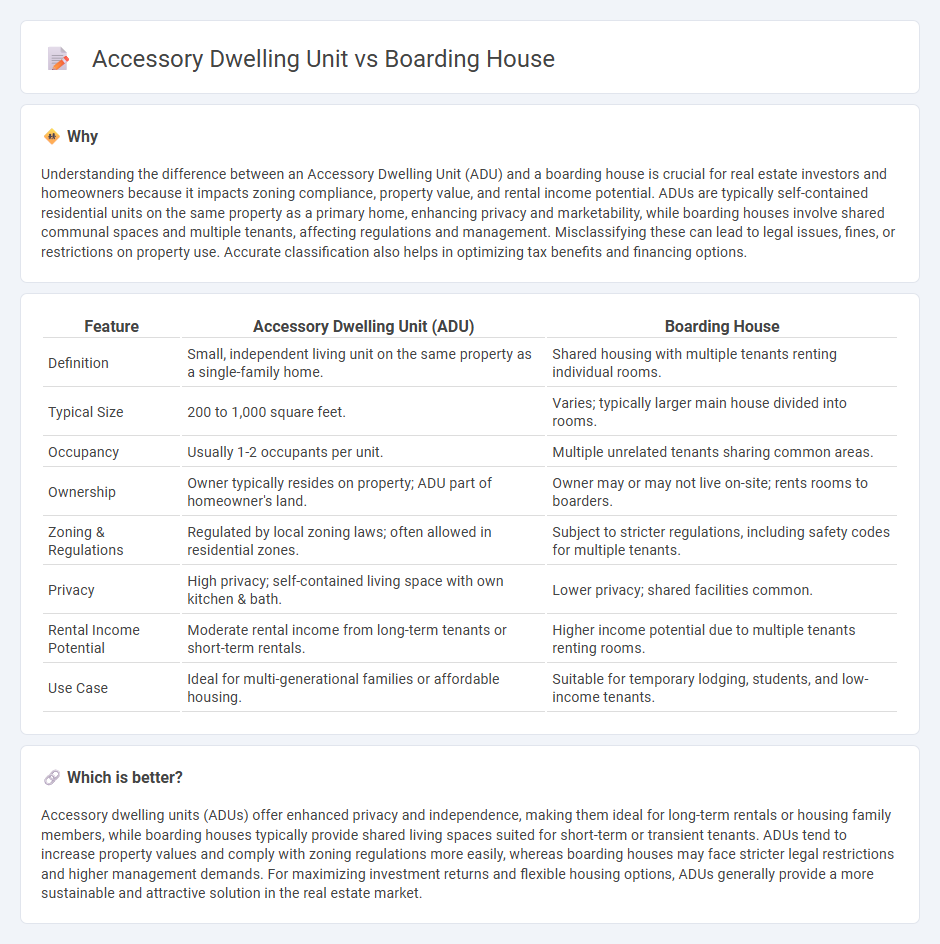
Accessory dwelling units (ADUs) are self-contained living spaces located on the same lot as a primary residence, often used for rental income or multigenerational living. Boarding houses provide shared accommodations with individual rooms and communal facilities, catering to transient tenants or affordable housing needs. Explore the benefits and regulations of each housing option to determine which suits your real estate goals.
Why it is important
Understanding the difference between an Accessory Dwelling Unit (ADU) and a boarding house is crucial for real estate investors and homeowners because it impacts zoning compliance, property value, and rental income potential. ADUs are typically self-contained residential units on the same property as a primary home, enhancing privacy and marketability, while boarding houses involve shared communal spaces and multiple tenants, affecting regulations and management. Misclassifying these can lead to legal issues, fines, or restrictions on property use. Accurate classification also helps in optimizing tax benefits and financing options.
Comparison Table
| Feature | Accessory Dwelling Unit (ADU) | Boarding House |
|---|---|---|
| Definition | Small, independent living unit on the same property as a single-family home. | Shared housing with multiple tenants renting individual rooms. |
| Typical Size | 200 to 1,000 square feet. | Varies; typically larger main house divided into rooms. |
| Occupancy | Usually 1-2 occupants per unit. | Multiple unrelated tenants sharing common areas. |
| Ownership | Owner typically resides on property; ADU part of homeowner's land. | Owner may or may not live on-site; rents rooms to boarders. |
| Zoning & Regulations | Regulated by local zoning laws; often allowed in residential zones. | Subject to stricter regulations, including safety codes for multiple tenants. |
| Privacy | High privacy; self-contained living space with own kitchen & bath. | Lower privacy; shared facilities common. |
| Rental Income Potential | Moderate rental income from long-term tenants or short-term rentals. | Higher income potential due to multiple tenants renting rooms. |
| Use Case | Ideal for multi-generational families or affordable housing. | Suitable for temporary lodging, students, and low-income tenants. |
Which is better?
Accessory dwelling units (ADUs) offer enhanced privacy and independence, making them ideal for long-term rentals or housing family members, while boarding houses typically provide shared living spaces suited for short-term or transient tenants. ADUs tend to increase property values and comply with zoning regulations more easily, whereas boarding houses may face stricter legal restrictions and higher management demands. For maximizing investment returns and flexible housing options, ADUs generally provide a more sustainable and attractive solution in the real estate market.
Connection
Accessory dwelling units (ADUs) and boarding houses both serve as flexible housing solutions that maximize property usage and increase rental income potential. ADUs typically provide private, self-contained living spaces on single-family lots, while boarding houses offer shared accommodations often with communal facilities. Both models address housing shortages by efficiently utilizing existing residential properties and expanding affordable rental options in urban areas.
Key Terms
Occupancy limits
Boarding houses typically have stricter occupancy limits regulated by local zoning codes, often capping the number of unrelated tenants per unit to prevent overcrowding. Accessory dwelling units (ADUs) usually face less stringent occupancy restrictions, designed primarily for single-family use or limited additional residents, depending on municipal ordinances. Explore local regulations to understand how occupancy limits impact your choice between boarding houses and ADUs.
Zoning regulations
Boarding houses and accessory dwelling units (ADUs) are subject to distinct zoning regulations that impact their feasibility and development. Boarding houses often face stricter zoning restrictions, including limits on occupancy, parking requirements, and proximity to other residential zones, aimed at maintaining neighborhood character and safety. Explore comprehensive zoning guidelines and local ordinances to understand the nuances of boarding houses versus accessory dwelling units in your area.
Lease agreements
Lease agreements for boarding houses typically accommodate multiple tenants with shared common areas, often requiring clear terms on individual room rentals and communal responsibilities. Accessory dwelling units (ADUs) involve a separate, self-contained living space on a single property, leading to lease terms focused on privacy, utilities, and independent access. Explore detailed comparisons of lease agreements tailored to boarding houses and ADUs for better property management insights.
Source and External Links
Boarding House - Wikipedia - A boarding house is a residence where lodgers rent rooms with shared facilities and sometimes meals provided.
Boarding House Bistro - Located in O'Fallon, IL, this bistro offers charcuterie boards and gift boxes for social gatherings.
The Boarding House - A historic event venue in Chicago offering elegant and sophisticated spaces for dining and gatherings.
 dowidth.com
dowidth.com